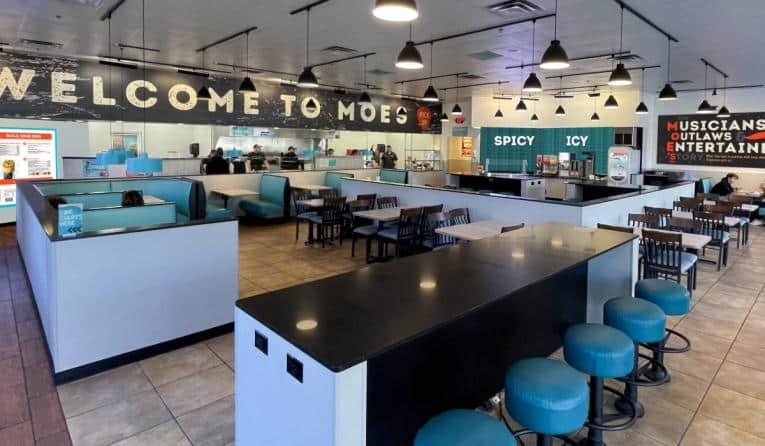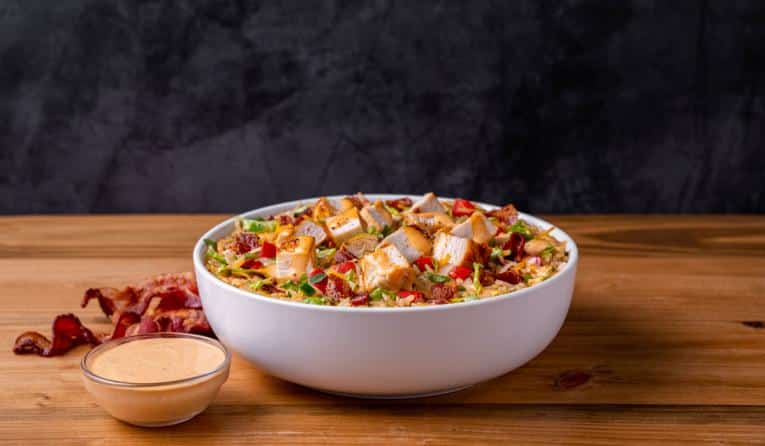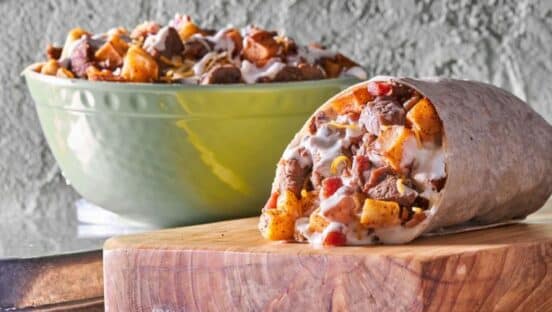Mark Monroe, one of the largest Moe’s Southwest Grill franchisees with 51 stores, isn’t shy with his assessment. Over the past couple of years or so, the Focus Brands’ chain has quietly tested and refined what it’s internally dubbed “Project VICTORY”—a broad-spectrum transformation at the roughly 640-unit brand.
“To me, the headline is, this is the best thing I’ve ever seen in the business in this industry, and I’m going on probably 14 years now,” Monroe says.
Monroe has been at the tip of the pilot spear, with many of his stores adjusting Project VICTORY’s changes over recent months, well before it was officially introduced in early June. And it’s beyond hyperbole—Monroe spent more money in 12 months on CapEx, he says, than anyone has in the 23-year-old history of the brand. It’ll amount to $3.5 million in one calendar year, “putting our money where our mouth is,” he says.
So what is Monroe referencing? It tracks back to March 2022 when Tory Bartlett, a three-year Focus exec, was appointed chief brand officer of Moe’s, a role he previously held at sister brand Schlotzsky’s. During his tenure with the sandwich chain, Bartlett introduced two new prototypes and overhauled the menu in an effort to streamline operations and boost kitchen efficiency.
A similar transformation was on Moe’s horizon. The brand wanted to improve offerings and service standards to raise customer experience. VICTORY unpacks as follows:
- (V)alidate necessary ingredients
- (I)mprove line efficiency and speed of service
- (C)lean up the appearance of food
- (T)ransform flavor profiles
- (O)ptimize omnichannel guest experience
- (R)edesign menuboard
- (Y)ield a brand that is built to grow
Bartlett began by dissecting data and speaking to stakeholders, from corporate to franchisees. “I had to understand where the business was and how we got there,” he says. “And what the opportunity was to make some changes to improve a lot of different things. The good thing is, honestly, I had Mark to help us get to the 50-yard line, if you will, on some of the improvements that we needed to have as it related to the menu and the guest journey experience.”
Let’s start from the top. Moe’s ingredient profile has always touted bold as a differentiator, whether it’s more ingredients on the line or sauces at the bar. “Validate” was a more nuanced approach than your typical pare down, however. In this case, Moe’s wanted to figure out what it could remove, but also what it could make better. For instance, pork is a product that came off due to product mix and testing. Yet it’s likely to return as a dialed-up version of its past self.
Each time, though, and with every ingredient, Moe’s gathered responses and reacted. Olives left and guests pushed back. Moe’s reversed course. Mushrooms vacated and the reaction was mostly muted. So they exited. Product changes tested for nearly six months across 80 restaurants. “Florida all the way up to New York,” Bartlett says.


Speed of service and line efficiency has been a multi-tiered development as well. And it gets down to granular details such as what customers view throughout their stay. There were white cutting boards before. Bartlett says these, naturally, would get dirty and guests noticed. Moe’s swapped them with stainless steel—one of Monroe’s ideas.
As customers queue up, they’d also often see ingredients spill over as employees built bowls and burritos. Moe’s took a look at how big pans were, what the service placement was, and just, overall, how it could clean up presentation.
Moe’s even rethought the spoon it was using to scoop ingredients. They were color coded previously, which Bartlett says could detract from the experience. You’d see green, yellow, and red portioning devices. The team tested different options and landed on a stainless steel spoon that doesn’t take away from the food. “The colors pop,” Bartlett says. “And it aligned with streamlining and making sure, for instance, when you see a quarter pan of chicken versus a nice half pan of chicken; that half pan might be half empty because we’re cooking to make sure we have the freshest product. But it visually looks more abundant.”
“And then, probably one of the most impactful things we created was to transform our flavor profile,” Bartlett adds. “We know there’s two things that guests really like about Moe’s. One, it’s the atmosphere. They love the look of Moe’s, but it’s also the flavors.’
Bartlett says Moe’s is the only brand among its competitive set to serve all-white meat chicken (it also has a dark option). Moe’s queso is the stuff of legend, too, he adds. But there was a clear chance to lean into all of it.
Moe’s ideated new sauces for the VICTORY evolution, including “Moe’s Sauce,” which is described by Chew Boom as Greek yogurt, red wine vinegar, and “Southwest spices.” There’s also a hotter “Kickin’ Cayenne” that comprises “three kinds of peppers and zesty seasonings,” and “Poblano Crema,” a mix of roasted poblano peppers, avocado, sour cream, garlic, and lime juice. Like Moe’s Sauce, it skews mild.
“We’ve always come out highest in taste in the surveys and so the sauces are just another way to give people choice into what they do,” Monroe says. “Again, to me, the headline is, in the last, probably 24 months, Moe’s has leapfrogged everybody else with what we’re bringing to market.”
Sales back Monroe’s enthusiasm. His Moe’s are in their third year of double-digit comps. The first was “9 percent and change,” then 14 percent last year, and 12 percent so far in 2023. “Most important is how does this impact sales,” he says. “Look, it’s a challenging environment. So all the changes we’re doing are counteracting that. Again, to me, it just goes back to the best—this is the best model of the brand right now.”
One highlight in particular stands out to Monroe. Moe’s update features a beverage station that’s, “by far,” he says, “the best in the nation.”
It’s visible as guests walk in, alongside the revamped salsa lineup. There’s a standard fountain setup with Coca-Cola offerings, tea, three different Hubert’s Lemonades, and a top-of-the-line self-serve ICEE machine Monroe says is a hit during Kid’s Eat Free days.
But not to be lost is “the good ice.” Moe’s even created a sticker that says, “we have the good ice” and pasted it to the machine. This might sound glib, but it’s a movement that’s been written about by everybody from The New Yorker to It’s a Southern Thing. Also known as “nugget ice,” or “pellet ice,” it’s layers of flaked ice frozen together—a process that creates pockets of air that make the ice chewy. Sonic Drive-In and Chick-fil-A are two brands that have satisfied this cult for years. Now, so is Moe’s.
“In all seriousness, there’s a subset of people, probably 20 percent, who know exactly what the good ice means,” Monroe says.

Tory Bartlett took the reins as Moe’s chief brand officer in March 2022.
The “O” in VICTORY, built around omnichannel growth, is one bucket that has space to grow for Moe’s, Bartlett says. The brand is looking at its tech stack as it relates to the point of sale all the way to the app. It’s building in-house capabilities where today there’s third-party reliance. “This is not done. Matter of fact, this is really just kicking off,” he says. “Focus Brands has made a huge investment in improving this across all of the brands.”
Continuing to “R,” over recent years, given Moe’s hasn’t changed its menu all that often, other than to remove some things (like the Junior Burrito), its menuboards haven’t evolved much, either. Bartlett says there wasn’t ample urgency since the majority of customers walk in knowing what they want. They don’t glance over. However, Moe’s growing sophistication with data opened whitespace on this front. It suddenly had the ability to craft options from real-time trends. And so, it began to showcase pre-build options alongside Moe’s iconic “Homewrecker,” which includes guac and has been a staple since the outset.
For instance, the No. 1 modifier, data showed, was double meat. In turn, Moe’s ideated a pre-build double meat burrito with one of the new sauces. “From the digital standpoint, it makes the experience a lot better for the guest,” Bartlett says. “They know they’re getting a great burrito. But also, our team members, it’s very easy to make it—it’s less customizable.”
The final point is positioning Moe’s for growth. Bartlett has a track record here as well. At Schlotzsky’s, he oversaw a record number of new deal signings in 2021 that added an additional 124 locations to the pipeline.
Moe’s has retracted of late. The brand had 719 outlets at the start of 2020 and closed 2022 with 637. It’s shuttered a net 22, 22, and 41 venues over the past three calendars, respectively. The current footprint is 636 corporate stores and one company-run unit (there were three of those before 2020 arrived).
Moe’s 2022 average-unit volume was $1.159 million. U.S. systemwide sales were $705.3 million.
How it’s stacked:
2021 (year-end domestic)
- Systemwide sales: $662 million
- AUV: $1.073 million
2020 (pandemic year)
- Systemwide sales: $560.6 million
- AUV: $814,672
2019 (pre-pandemic view)
- Systemwide sales: $730.9 million
- AUV: $1.077 million
Bartlett says the equation is straightforward: franchisees will grow when they’re making money and hitting margins. Yet that’s hardly been elementary during inflationary times. Commodities, third-party fees, construction, and on it goes, have all climbed. Revenues, though, haven’t scaled at the same pace and either has flow through, Bartlett says.
“We really want to be hyper focused on everything we do,” he says. “Driving top-line sales—that’s table stakes, right? You have to grow AUV. We can get real aggressive with that and the things we did. But we also have to make sure the flow through and margins, and quite honestly, the return on investment for new locations, was right.”
“That’s why part of this is making sure we have a prototype we can build,” Bartlett adds.
The new design can go as small as 1,800 square feet (it can also flex up as needed). Beyond the added agility, it boasts a new décor package that ties into Moe’s “rebel sprit.” There’s a sharper color of teal and, overall, the building is brighter. Old units often had black ceilings. This build features upgraded booths and seating and emphasizes the line so food is the show. “You come in and see great food,” Bartlett says. “So the amount of glass that you have. The stainless steel [mentioned earlier].”

In the one ground-up new prototype built thus far, Moe’s changed where the cookline was. The guest’s line of sign is now on ingredients and not a grill that was just cooked on 10 minutes ago, with food particles scattered about. “As any brand goes, you get to a point and say, ‘OK what do we look like and feel like? Does the food match the décor? Does the music fit?’ One thing we tried to make sure was it all tied together,” Bartlett says. “… Rebel spirit is the musicians, outlaws, entertainers. When you think of rebel spirit, it’s not a destroyer, it’s a creator. It’s someone who is magnetic and inventors and adventurers, is what it is.”
As Bartlett points out, Moe’s was not—despite many people’s assumptions—named after a person named “Moe.” It stands for “Musicians, Outlaws, and Entertainers.”
“Forever, the brand at the beginning only played dead artist’s music in there,” he says. “The décor had represented that. So the brand kind of drifted over the years and going in different directions and tried some different things.”
Monroe digs in on an earlier point. “I’d say, right now, the Moe’s prototype, I think, is best in class,” he says. “And I’m talking about Chipotle, QDOBA, and all the other smaller guys.”
In regard to development, Bartlett says Moe’s is showing the new look—and results—to franchisees hoping to incentivize them to engage ahead of contractual obligations to remodel.
“There’s a lot of different variations of the facility out there for Moe’s over the years,” he notes. “And so, our franchisees know that one of the best things you can do to grow your sales is to make sure you have a consistent, clean-looking facility.”
Bartlett adds there’s been a good deal of interest from operators to upgrade ahead of terms. But if not, when the date comes, they’ll do so toward the Project VICTORY future of Moe’s. Some of the changes, like moving the cookline, are not required of existing locations; only new builds.
Going forward, Bartlett says, catering is a piece of Moe’s profitability puzzle that’s only going to accelerate. It gets the branding in front of new guests and offers a fresh occasion to loyal ones. Moe’s has tried to ensure there’s enough space to execute catering in the design. “We’ve only scratched the surface as far as what we can do as a brand from a catering standpoint,” he says.
And more generally, Monroe says, Moe’s has rapidly evolved under Bartlett’s leadership, and will continue to do so.
“Put us on the watch list,” he says. “Great things are happening.”








